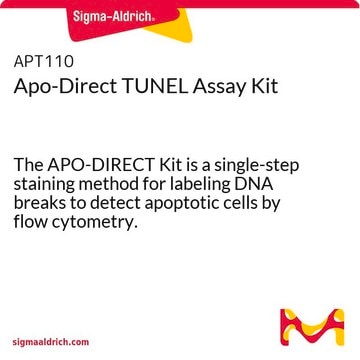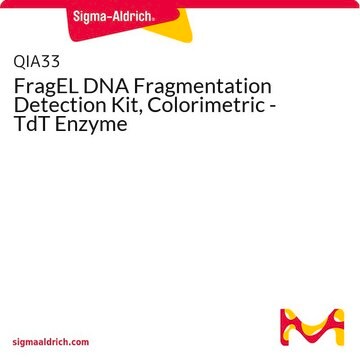11684795910
Roche
In Situ Cell Death Detection Kit, Fluorescein
sufficient for ≤50 tests, suitable for detection
Synonym(s):
Fluorescein-12-UTP tetralithium salt, Fluorescein-5(6)-carboxamidocaproyl-(5-[3-aminoallyl]uridine 5′-triphosphate)
Sign Into View Organizational & Contract Pricing
All Photos(2)
About This Item
UNSPSC Code:
12352200
Recommended Products
usage
sufficient for ≤50 tests
Quality Level
manufacturer/tradename
Roche
technique(s)
flow cytometry: suitable
application(s)
detection
storage temp.
−20°C
General description
Kit for the detection and quantification of apoptosis at the single-cell level, based on labeling of DNA strand breaks (TUNEL technology); analysis by fluorescence microscopy or flow cytometry.
Widely used methods to determine apoptosis include the analysis of the genomic DNA by agarose-gel electrophoresis and DNA fragmentation assays based on 3H-thymidine and, alternatively, 5-Bromo-2′-deoxy-uridine. The methods involve the separation of fragmented, low molecular weight DNA from unfragmented, high molecular weight DNA in a given cell population. Thus, these methods do not provide information about the fate of an individual cell in a given cell population, or particularly, in tissue sections. Alternatively, individual apoptotic cells may be microscopically recognized because of the characteristic appearance of nuclear chromatin condensation and fragmentation, but this method is subjective and limited to a relatively narrow time window when the morphological changes are at a maximum.
The hallmark of apoptosis is DNA degradation, which in early stages, is selective to the internucleosomal DNA linker regions. The DNA cleavage may yield double-stranded and single-stranded DNA breaks (nicks). Both types of breaks can be detected by labeling the free 3′-OH termini with modified nucleotides (e.g., biotin-dUTP, DIG-dUTP, fluorescein-dUTP) in an enzymatic reaction. The enzyme terminal deoxynucleotidyl transferase (TdT) catalyzes the template-independent polymerization of deoxyribonucleotides to the 3′-end of single- and double-stranded DNA. This method has also been termed TUNEL (TdT-mediated dUTP-X nick end labeling). Alternatively, free 3′-OH groups may be labeled using DNA polymerases by the template-dependent mechanism called nick translation. However, the TUNEL method is considered to be more sensitive and faster.
The hallmark of apoptosis is DNA degradation, which in early stages, is selective to the internucleosomal DNA linker regions. The DNA cleavage may yield double-stranded and single-stranded DNA breaks (nicks). Both types of breaks can be detected by labeling the free 3′-OH termini with modified nucleotides (e.g., biotin-dUTP, DIG-dUTP, fluorescein-dUTP) in an enzymatic reaction. The enzyme terminal deoxynucleotidyl transferase (TdT) catalyzes the template-independent polymerization of deoxyribonucleotides to the 3′-end of single- and double-stranded DNA. This method has also been termed TUNEL (TdT-mediated dUTP-X nick end labeling). Alternatively, free 3′-OH groups may be labeled using DNA polymerases by the template-dependent mechanism called nick translation. However, the TUNEL method is considered to be more sensitive and faster.
Specificity
The TUNEL reaction preferentially labels DNA strand breaks generated during apoptosis. This allows discrimination of apoptosis from necrosis and from primary DNA strand breaks induced by cytostatic drugs or irradiation.
Application
The In Situ Cell Death Detection Kit, Fluorescein, is a precise, fast, and simple nonradioactive technique to detect and quantify apoptotic cell death at the single-cell level by fluorescence microscopy and quantitative detection by flow cytometry in cells and tissues. Thus, the In Situ Cell Death Detection Kit can be used in many different assay systems.
Examples are:
Examples are:
- Detection of individual apoptotic cells in frozen and formalin-fixed tissue sections in basic research
- Determination of sensitivity of malignant cells to drug-induced apoptosis in cancer research
- Typing of cells undergoing cell death in heterogeneous populations by double staining procedures
Features and Benefits
- Sensitive: The direct labeling procedure using fluorescein-dUTP reduces background labeling
- Fast: The use of fluorescein-dUTP allows analysis of the samples directly after the TUNEL reaction
- Convenient: No secondary detection system required
- Accurate: Identification of apoptosis at a molecular level (DNA-strand breaks) and identification of cells at the very early stages of apoptosis
Packaging
1 kit containing 2 components.
Preparation Note
Working solution: Add total volume (50 μl) of Enzyme Solution to the remaining 450 μl Label Solution to obtain 500 μl TUNEL reaction mixture.
Mix well to equilibrate components.
Mix well to equilibrate components.
Other Notes
For life science research only. Not for use in diagnostic procedures.
Kit Components Only
Product No.
Description
- Enzyme Solution (TdT)
- Label Solution (fluorescein-dUTP)
Signal Word
Danger
Hazard Statements
Precautionary Statements
Hazard Classifications
Aquatic Chronic 2 - Carc. 1B Inhalation
Storage Class Code
6.1D - Non-combustible acute toxic Cat.3 / toxic hazardous materials or hazardous materials causing chronic effects
WGK
WGK 3
Flash Point(F)
does not flash
Flash Point(C)
does not flash
Choose from one of the most recent versions:
Already Own This Product?
Find documentation for the products that you have recently purchased in the Document Library.
Customers Also Viewed
Laura Perin et al.
PloS one, 5(2), e9357-e9357 (2010-03-03)
Acute Tubular Necrosis (ATN) causes severe damage to the kidney epithelial tubular cells and is often associated with severe renal dysfunction. Stem-cell based therapies may provide alternative approaches to treating of ATN. We have previously shown that clonal c-kit(pos) stem
Zengxia Li et al.
Biologics : targets & therapy, 1(4), 455-463 (2007-12-01)
Medullary thyroid carcinoma (MTC), a neuroendocrine tumor arising from the thyroid gland, is known to be poorly responsive to conventional chemotherapy. The root of Stemona tuberosa Lour, also called Bai Bu, is a commonly used traditional Chinese anti-tussive medicine. The
Shih Lung Cheng et al.
Respiratory research, 10, 115-115 (2009-11-26)
Although both animal and human studies suggested the association between placenta growth factor (PlGF) and chronic obstructive pulmonary disease (COPD), especially lung emphysema, the role of PlGF in the pathogenesis of emphysema remains to be clarified. This study hypothesizes that
Parco M Siu et al.
Journal of applied physiology (Bethesda, Md. : 1985), 107(4), 1266-1275 (2009-08-01)
Pressure ulcer is a complex and significant health problem. Although the factors including pressure, shear, and ischemia have been identified in the etiology of pressure ulcer, the cellular and molecular mechanisms that contribute to the development of pressure ulcer are
Raphaël Roduit et al.
Apoptosis : an international journal on programmed cell death, 13(3), 343-353 (2008-02-07)
The retinal pigment epithelium (RPE) is constantly exposed to external injuries which lead to degeneration, dysfunction or loss of RPE cells. The balance between RPE cells death and proliferation may be responsible for several diseases of the underlying retina, including
Our team of scientists has experience in all areas of research including Life Science, Material Science, Chemical Synthesis, Chromatography, Analytical and many others.
Contact Technical Service










